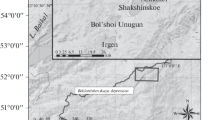Abstract
Lake Gallocanta has undergone drastic changes during the last thirteen years. Water level changed from a high level (Zmax = 2 m) to total dryness in 1985. From 1986 to 1988 slow refilling occurred. The water volume fluctuations have been studied in relation to climatic variations recorded for that period. Variations in the major dissolved ions were related to water volume fluctuations from data at two different stages, one corresponding to the drying phase and another to the refilling phase. Mineralogical composition of the salts precipitated at different stages was examined by X-ray diffraction. Interstitial water and mineralogical composition of recent sediments were also studied along a transect through the lake.
The water column decrease from 1977 to 1985 is related to decreasing annual rainfall (500-250 mm respectively). The refilling in 1986–1988 is due to high annual rainfall (537 mm). In addition to these fluctuations, seasonal changes of the water level between 20 and 50 cm occurred every year.
Gallocanta is a Na-Mg-Cl-(SO4) type lake. During the drying period a typical salt enrichment occurs with linear relationships between TDS, Cl, Na and K. Alkalinity is linearly correlated with Ca at relatively low salinities. As salinity increases a linear relationship between Ca and SO4 is observed. Minerals formed from the brine are halite, bischofite, epsomite, hexahydrite, mirabilite, gypsum, aragonite, calcite and dolomite. The molar ratio Mg/Ca of the interstitial water changes from 1.5 along the shorelines, where calcite and aragonite precipitate, to 40 in the center of the lake. Sediment cores from the central part of the lake show aragonite in the top layers, magnesian calcite and low proportions of quartz and illite, while at 20 cm depth a high proportion of gypsum is present. In contrast, cores from the shore of the lake are mainly composed of low magnesium calcite in the top layers and low magnesium calcite together high magnesium calcite and dolomite between 30 and 70 cm depth. Gypsum deposits only occur in significant proportions at 80–100 cm depth.
The refilling process showed relationships between volume and salt concentration following the Langbein model. The salt mass in solution decreased about 50% from the drying to the refilling phase. However, Mg content decreased about 70 % for the same period, suggesting a contribution of this element to the dolomite formation.
Similar content being viewed by others
References
APHA-AWWA-WPCF, 1980. Standard methods for the examination of water and wastewater. APHA, Washington. 1134 pp.
Bayly, I. A. E., 1970. Further studies on some saline lakes of south-east Australia. Aust. J. mar. Freshwat. Res. 21: 117–129.
Bayly, I. A. E. & W. D. Williams, 1966. Chemical and biological studies on some saline lakes of south-east Australia. Aust. J. mar. Freshwat. Res. 17: 177–228.
Bowler, J. M., 1981. Australian salt lakes. a paleohydrologic approach. Hydrobiologia 82: 431–444.
Comín, F. A., M. Alonso, P. López & M. Comelles, 1983. Limnology of Gallocanta Lake, Aragón, Northeastern Spain. Hydrobiologia, 105: 207–221.
Comín, F. A. & M. Alonso, 1988. Spanish salt lakes: their chemistry and biota. Hydrobiologia 158: 237–245.
Dunnette, D. I., D. P. Chynoweth & K. H. Mancy, 1985. The sources of hydrogen sulfide in anoxic sediment. Wat. Res. 19: 875–884.
Eugster, H. P. & L. A. Hardie, 1978. Saline Lakes. In: A. Lerman (ed.). Lakes. Chemistry, geology, physics. Springer-Verlag. New York: 237–293.
Fritz, J. S. & S. S. Yamamura, 1955. Rapid microtitration of sulphates. Anal. Chem. 26: 1461–1464.
Golterman, H. L., R. S. Clymo & M. A. M. Ohnstad (eds.), 1978. Methods for physical and chemical analysis of freshwaters. Blackwell Sc. publ. Oxford. 214 pp.
Hammer, U., 1986. Saline lake ecosystems of the world. (Monographiae Biologicae, 59). Junk Publishers, 616 pp.
Jacobson, G. & A. W. Schuett, 1979. Water levels balance and chemistry of lake George, New South Wales. BMR J. Aust. Geol. Geophys. 4: 25–32.
Jones, B. F., H. P. Eugster & S. L. Rettig, 1977. Hydrochemistry of the lake Magadi Basin, Kenya. geochem. Cosmodrim. Acta 41: 53–72.
Kalk, M., A. J. McLachlan & C. Howard-Williams (eds.), 1979. Lake Chilwa. Studies of change in a tropical ecosystem. Dr. W. Junk Publishers. The Hague. 462 pp.
Kilham, P., 1984. Sulfate in African inland waters: sulfate to chloride ratios. Ver. int. Ver. Limnol. 22: 296–302.
Kilham, P. & P. L. Cloke, 1990. The evolution of saline lake waters: gradual and rapid biogeochemical pathways in the Basotu Lake District, Tanzania. Hydrobiologia 197: 35–50.
Langbein, W. B., 1961. Salinity and hydrology of closed lakes. U.S.G.S. Prof Paper 412, US Gort. Print. Office, Washington, 220 pp.
Martínez, B. & F. Plana, 1987. Quantitative X Ray diffraction of carbonate sediments: mineralogical analysis through fitting of Lorentzian profiles to diffraction peaks. Sedimentology 34: 169–174.
Phillips, K. N. & A. S. Van Denburgh, 1971. Hydrology and geochemistry of Albert, summer and Goose Lakes and other closed basin lakes in South-Central Oregon. LL.S. G. S. Prof. Paper 502-B, 86 pp.
Pueyo, J. J., 1978. La precipitación evaporítica actual en las lagunas saladas del área: Bujuraloz, Sástago, Caspe, Alcañiz y Calanda (provincias de Zaragoza y Teruel), Rev. Inst. Inv. Geol. Dip. Prov. Barcelona 33: 5–56.
Walker, K. F., 1973. Studies on a saline lake ecosystem. Aust. J. mar. Freshwat. Res. 24: 21–71.
Williams, W. D., 1966. Conductivity and the concentration of total dissolved solids in Australia lakes. Aust. J. mar. Freshwat. Res. 17: 169–176.
Williams, W. D. & M. J. Kokkinn,1988. The biogeographical affinities of the fauna in episodically fitted salt lakes: A study of Lake Eyre South, Australia. Hydrobiologia, 158: 227–236.
Author information
Authors and Affiliations
Rights and permissions
About this article
Cite this article
Comín, F.A., Juliá, R., Comín, M.P. et al. Hydrogeochemistry of Lake Gallocanta (Aragón, NE Spain). Hydrobiologia 197, 51–66 (1990). https://doi.org/10.1007/BF00026938
Issue Date:
DOI: https://doi.org/10.1007/BF00026938




